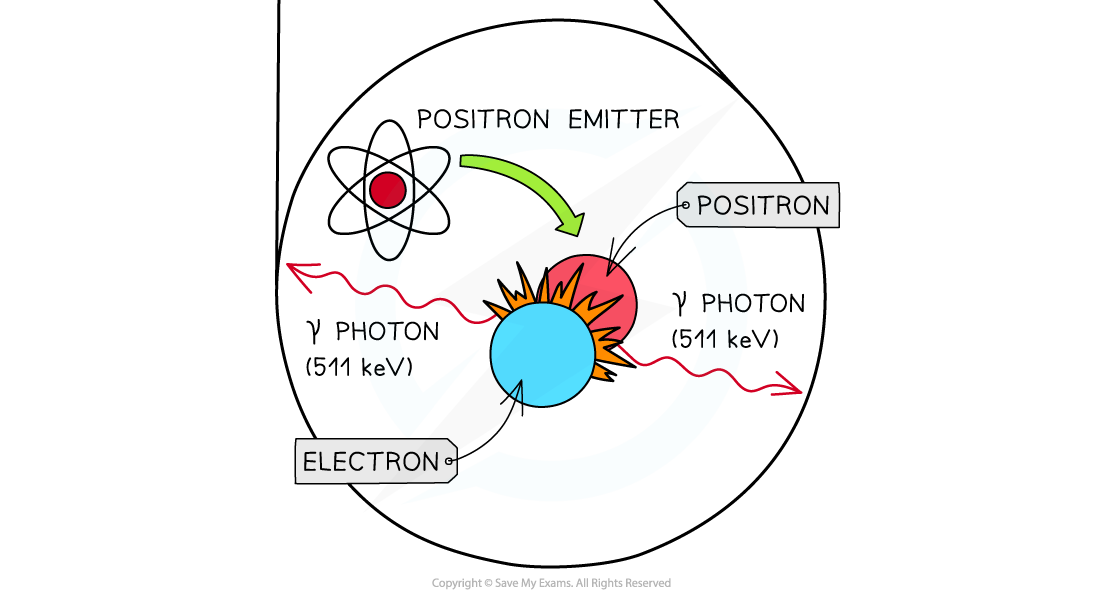Medical Uses of Radiation (Edexcel GCSE Physics): Revision Note
Exam code: 1PH0
Radiotherapy
Radiotherapy
Radiotherapy is the name given to the treatment of cancer using radiation
Although radiation can cause cancer, it is also highly effective at treating it
Radiation can kill living cells
Some cells, such as bacteria and cancer cells, are more susceptible to radiation than others
During external radiotherapy, beams of gamma rays are directed at the cancerous tumour
Surrounding healthy tissue tends to be shielded to avoid causing any damage

During radiotherapy, the beams are moved around to minimise harm to healthy tissue whilst still being aimed at the tumour
During internal radiotherapy, small pellets of radioactive materials can also be inserted into a tumour exposing it directly to radiation
PET Scanners and Tracers
Medical Tracers
A tracer is a radioactive isotope that can be used to track the movement of substances, like blood, around the body
Gamma emitters are usually used for this purpose
Gamma rays are highly penetrating and so will be able to pass through the body and be detected outside the body
This allows an internal image of the body to be created

Iodine-131 is an example of a radioactive tracer
Since gamma rays are less ionising than some other forms of radiation, the harm caused to the patient is also minimised
As well as choosing a gamma emitter:
The amount of isotope used is kept to a minimum to reduce people’s exposure to radiation
Isotopes are chosen that have short half-lives of around a few hours: Long enough to carry out the procedure, but not so long that they cause long term harm
Positron Emission Tomography (PET)
In PET scanning positrons are emitted by the decay of the tracer
They travel a small distance and annihilate when they interact with electrons in the tissue
This produces a pair of gamma-rays (also called gamma (γ) photons) which can be detected outside the body


The photons (produced by the annihilation of the electron and positron) are detected outside the body. keV are a unit of energy.
Worked Example
A new medical tracer is required for investigating the absorption of a particular substance found in blood around the body.

Which of the different isotopes in the table would be most suitable?
Answer: C
A suitable medical tracer must:
Be able to penetrate out of the body
Have a long enough half-life to move around the body before it decays away
Have a short enough half-life that it won’t remain in the body at dangerous levels for too long
The answer is not A because alpha radiation cannot penetrate out of the body
The answer is not B because the half-life is too short
The answer is not D because the half-life is too long
Isotope Production
When carrying out procedures involving the use of radioactive isotopes, such as the PET scan, the amount used is kept to a minimum to reduce people’s exposure to radiation
Isotopes are chosen that have short half-lives of around a few hours: Long enough to carry out the procedure, but not so long that they cause long term harm
Because of the short half-life of the isotopes involved, the isotopes have to be produced nearby – otherwise they would have decayed too much by the time they reached the hospital and be unusable
Examiner Tips and Tricks
The use of radiation in medicine carries risk. However, the benefits of using radiation in medicine can out way the potential risks: the risks posed by the radiation are smaller than the risks associated with leaving the condition untreated. You may be given data and asked to evaluate the risk of nuclear radiation in a particular example. Remember to compare the potential dangers with the benefits.

Unlock more, it's free!
Did this page help you?